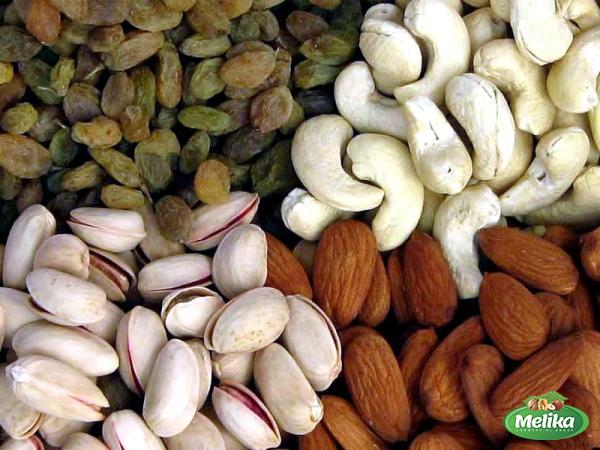The global cashew market is experiencing steady growth due to increasing consumer demand for healthy snacks and the versatile uses of cashews in the food industry. As one of the most widely consumed tree nuts, cashews are known for their nutritional benefits, unique flavor, and culinary versatility. This summary provides an overview of the cashew market, including key trends, drivers, challenges, and opportunities. Key Trends in the Cashew Market: 1. Increasing Consumption: Cashews have gained popularity for their nutritional value, including high levels of protein, healthy fats, vitamins, and minerals. As a result, there is a growing demand for cashews as a healthy snack option, both in developed and emerging markets. 2. Rising Demand for Plant-Based Diets: The increasing adoption of plant-based diets is driving the demand for alternative protein sources. Cashews, being a rich source of protein and essential nutrients, are becoming a popular choice among consumers, contributing to the growth of the market. 3. Innovation in Product Offerings: The cashew market is witnessing innovation in terms of product offerings. Manufacturers are introducing flavored cashews, such as roasted, salted, and spiced varieties, to cater to diverse consumer preferences. Additionally, cashew-based products, such as cashew milk, butter, and cheese, are gaining traction in the market, providing alternatives for individuals with dairy allergies or those following vegan diets. 4. Growing Popularity in the Food Industry: Cashews are widely used in the food industry as an ingredient in various dishes, including stir-fries, curries, desserts, and baked goods. Their unique flavor and versatile application make them a popular choice among chefs and food manufacturers, thus driving the demand for cashews. Drivers of the Cashew Market: 1. Globalization and Increasing Trade: The cashew industry is highly influenced by international trade, with several countries being major producers and exporters. This globalization has led to increased availability of cashew nuts in various markets, driving the overall consumption. 2. Health Consciousness and Rising Disposable Income: With the growing emphasis on health and well-being, consumers are increasingly opting for nutritious, high-quality food products. Cashews, being a source of healthy fats and essential nutrients, are preferred by health-conscious consumers. Additionally, rising disposable income levels in developing countries are enabling more consumers to afford cashew products. 3. Convenience and Snackification Trends: The convenience factor plays a significant role in driving the consumption of cashews. As an easily accessible and portable snack option, cashews are favored by busy individuals looking for nutritious on-the-go snacks. The trend towards snackification, where consumers seek out healthy and satisfying snack options, further boosts the demand for cashews. Challenges in the Cashew Market: 1. Price Volatility: The cashew industry is prone to price volatility due to factors such as seasonal variations, climate conditions, and global market dynamics. Fluctuating prices can impact the profitability of cashew farmers, processors, and traders, thereby posing challenges to the industry’s growth. 2. Sustainability and Labor Issues: Cashew production involves labor-intensive processes, from harvesting to processing. Ensuring fair wages, safe working conditions, and environmentally sustainable practices throughout the supply chain remain challenges for the industry. The demand for ethically sourced cashews is growing, which puts pressure on producers to adopt sustainable practices. Opportunities in the Cashew Market: 1. Emerging Markets: Developing countries represent significant growth opportunities for the cashew market.

nuts
 Rising disposable income, urbanization, and changing dietary preferences in these regions contribute to increased consumption of cashew products. As a result, there is growing interest among market players to expand their presence in these markets. 2. Product Diversification: With the increased interest in plant-based diets and healthy snacking, there is immense potential for product diversification within the cashew market. Manufacturers can introduce innovative cashew-based products, including snacks, spreads, beverages, and desserts, to cater to changing consumer demands. 3. Regional and Organic Market Segments: There is a growing trend towards locally sourced and organic products in the food industry. Cashew producers can tap into this opportunity by establishing regional supply chains and promoting organic cultivation practices. This approach ensures traceability, reduces carbon footprints, and appeals to environmentally conscious consumers. In conclusion, the cashew market is witnessing steady growth driven by increasing consumer demand for healthy snacks, rising adoption of plant-based diets, and the versatility of cashews in the food industry. However, challenges such as price volatility, sustainability, and labor issues need to be addressed. Expanding into emerging markets, diversifying product offerings, and targeting regional and organic market segments present significant opportunities for market players. Overall, the future of the cashew market looks promising, with continued growth expected in the coming years. The cashew market has witnessed significant growth in recent years, driven by factors such as increasing consumer demand for healthy snacks, the rising popularity of plant-based diets, and the versatility of cashews in the food industry. However, like any industry, the cashew market is not without its challenges. In this article, we will explore the key trends shaping the cashew market, the challenges that businesses in the industry face, and the opportunities that lie ahead. I. Increasing Consumption of Cashews: The growing awareness of the nutritional benefits of cashews has fueled their consumption worldwide. Cashews are a rich source of protein, healthy fats, vitamins, and minerals, making them a popular choice for health-conscious consumers. As a result, the demand for cashews as a healthy snack option has been on the rise, not only in developed markets but also in emerging markets where disposable incomes are increasing. II. Changing Dietary Preferences and the Rise of Plant-Based Diets: The increasing adoption of plant-based diets has had a positive impact on the cashew market. As more individuals opt for a vegetarian or vegan lifestyle, cashews provide an excellent source of protein and essential nutrients. With their versatile applications in various dishes, cashews have become a preferred choice for individuals looking to add flavor, texture, and nutrition to their meals without relying on animal-based products.
Rising disposable income, urbanization, and changing dietary preferences in these regions contribute to increased consumption of cashew products. As a result, there is growing interest among market players to expand their presence in these markets. 2. Product Diversification: With the increased interest in plant-based diets and healthy snacking, there is immense potential for product diversification within the cashew market. Manufacturers can introduce innovative cashew-based products, including snacks, spreads, beverages, and desserts, to cater to changing consumer demands. 3. Regional and Organic Market Segments: There is a growing trend towards locally sourced and organic products in the food industry. Cashew producers can tap into this opportunity by establishing regional supply chains and promoting organic cultivation practices. This approach ensures traceability, reduces carbon footprints, and appeals to environmentally conscious consumers. In conclusion, the cashew market is witnessing steady growth driven by increasing consumer demand for healthy snacks, rising adoption of plant-based diets, and the versatility of cashews in the food industry. However, challenges such as price volatility, sustainability, and labor issues need to be addressed. Expanding into emerging markets, diversifying product offerings, and targeting regional and organic market segments present significant opportunities for market players. Overall, the future of the cashew market looks promising, with continued growth expected in the coming years. The cashew market has witnessed significant growth in recent years, driven by factors such as increasing consumer demand for healthy snacks, the rising popularity of plant-based diets, and the versatility of cashews in the food industry. However, like any industry, the cashew market is not without its challenges. In this article, we will explore the key trends shaping the cashew market, the challenges that businesses in the industry face, and the opportunities that lie ahead. I. Increasing Consumption of Cashews: The growing awareness of the nutritional benefits of cashews has fueled their consumption worldwide. Cashews are a rich source of protein, healthy fats, vitamins, and minerals, making them a popular choice for health-conscious consumers. As a result, the demand for cashews as a healthy snack option has been on the rise, not only in developed markets but also in emerging markets where disposable incomes are increasing. II. Changing Dietary Preferences and the Rise of Plant-Based Diets: The increasing adoption of plant-based diets has had a positive impact on the cashew market. As more individuals opt for a vegetarian or vegan lifestyle, cashews provide an excellent source of protein and essential nutrients. With their versatile applications in various dishes, cashews have become a preferred choice for individuals looking to add flavor, texture, and nutrition to their meals without relying on animal-based products.
Specifications of nuts
 III. Innovation in Product Offerings: To cater to evolving consumer preferences, manufacturers in the cashew market are introducing innovative product offerings. Flavored cashews, such as roasted, salted, and spiced varieties, are gaining popularity among consumers looking for unique and exciting snack options. Moreover, cashew-based products, including cashew milk, butter, and cheese, are emerging as dairy alternatives, attracting consumers with lactose intolerance or those following vegan diets. IV. Cashews in the Food Industry: Cashews have long been a staple ingredient in the food industry. Their unique flavor and versatility make them an excellent addition to various culinary creations. From savory dishes like stir-fries and curries to sweet treats like cakes and ice cream, cashews enhance the taste and texture, making them a preferred choice for chefs and food manufacturers. Their popularity in the food industry contributes to the overall growth of the cashew market. V. Globalization and Increasing Trade: The cashew market is highly influenced by international trade. Several countries, including India, Vietnam, and Ivory Coast, are major producers and exporters of cashews. Globalization has led to increased availability of cashew nuts in various markets, driving overall consumption. The ease of trade and transportation, coupled with the growing demand for cashews, present opportunities for businesses to expand their operations and tap into new markets. VI. Health Consciousness and Rising Disposable Income: The rising emphasis on health and well-being has fueled the demand for nutritious food products, including cashews. Consumers are willing to pay a premium for high-quality, healthy snacks, creating opportunities for businesses in the cashew market to differentiate themselves based on product quality and nutritional value. Additionally, increasing disposable incomes in developing countries enable more consumers to afford cashew products, expanding the potential customer base. VII. Convenience and Snackification Trends: In today’s fast-paced world, convenience plays a crucial role in consumers’ food choices. Cashews, being a convenient and portable snack option, cater to the needs of busy individuals looking for nutritious on-the-go snacks. The trend towards “snackification,” where consumers seek out small, satisfying snacks throughout the day, further fuels the demand for cashews. Businesses in the cashew market can capitalize on this trend by offering convenient and portion-controlled packaging options. VIII. Price Volatility: One of the major challenges faced by businesses in the cashew market is price volatility. Cashew nuts are susceptible to price fluctuations due to factors such as seasonal variations, climate conditions, and global market dynamics. These fluctuations impact the profitability of cashew farmers, processors, and traders. To mitigate this challenge, businesses need to closely monitor market conditions, hedge against price risks, and establish long-term relationships with suppliers to ensure stable pricing.
III. Innovation in Product Offerings: To cater to evolving consumer preferences, manufacturers in the cashew market are introducing innovative product offerings. Flavored cashews, such as roasted, salted, and spiced varieties, are gaining popularity among consumers looking for unique and exciting snack options. Moreover, cashew-based products, including cashew milk, butter, and cheese, are emerging as dairy alternatives, attracting consumers with lactose intolerance or those following vegan diets. IV. Cashews in the Food Industry: Cashews have long been a staple ingredient in the food industry. Their unique flavor and versatility make them an excellent addition to various culinary creations. From savory dishes like stir-fries and curries to sweet treats like cakes and ice cream, cashews enhance the taste and texture, making them a preferred choice for chefs and food manufacturers. Their popularity in the food industry contributes to the overall growth of the cashew market. V. Globalization and Increasing Trade: The cashew market is highly influenced by international trade. Several countries, including India, Vietnam, and Ivory Coast, are major producers and exporters of cashews. Globalization has led to increased availability of cashew nuts in various markets, driving overall consumption. The ease of trade and transportation, coupled with the growing demand for cashews, present opportunities for businesses to expand their operations and tap into new markets. VI. Health Consciousness and Rising Disposable Income: The rising emphasis on health and well-being has fueled the demand for nutritious food products, including cashews. Consumers are willing to pay a premium for high-quality, healthy snacks, creating opportunities for businesses in the cashew market to differentiate themselves based on product quality and nutritional value. Additionally, increasing disposable incomes in developing countries enable more consumers to afford cashew products, expanding the potential customer base. VII. Convenience and Snackification Trends: In today’s fast-paced world, convenience plays a crucial role in consumers’ food choices. Cashews, being a convenient and portable snack option, cater to the needs of busy individuals looking for nutritious on-the-go snacks. The trend towards “snackification,” where consumers seek out small, satisfying snacks throughout the day, further fuels the demand for cashews. Businesses in the cashew market can capitalize on this trend by offering convenient and portion-controlled packaging options. VIII. Price Volatility: One of the major challenges faced by businesses in the cashew market is price volatility. Cashew nuts are susceptible to price fluctuations due to factors such as seasonal variations, climate conditions, and global market dynamics. These fluctuations impact the profitability of cashew farmers, processors, and traders. To mitigate this challenge, businesses need to closely monitor market conditions, hedge against price risks, and establish long-term relationships with suppliers to ensure stable pricing.
buy nuts
 IX. Sustainability and Labor Issues: Cashew production involves labor-intensive processes, from harvesting to processing. Ensuring fair wages, safe working conditions, and environmentally sustainable practices throughout the supply chain remains a challenge for the industry. Moreover, the increasing demand for ethically sourced cashews requires businesses to focus on sustainability and transparency. Engaging in responsible sourcing practices and supporting initiatives that promote social and environmental sustainability can help businesses differentiate themselves and meet the expectations of conscious consumers. X. Expanding into Emerging Markets: Developing countries present significant growth opportunities for businesses in the cashew market. Rising disposable incomes, urbanization, and changing dietary preferences in these regions contribute to increased consumption of cashew products. To tap into these markets, businesses need to understand the local culture and consumer preferences, adapt their product offerings accordingly, and establish strong distribution networks. XI. Product Diversification: There is immense potential for product diversification within the cashew market. Businesses can introduce innovative cashew-based products, including snacks, spreads, beverages, and desserts, to cater to evolving consumer demands. This diversification allows businesses to target different consumer segments, capitalize on emerging trends, and differentiate themselves from competitors. XII. Regional and Organic Market Segments: The trend towards locally sourced and organic products presents opportunities for businesses in the cashew market. Establishing regional supply chains and promoting organic cultivation practices can enhance traceability, reduce carbon footprints, and appeal to environmentally conscious consumers. Businesses can collaborate with local farmers and invest in sustainable farming practices to access niche markets and gain a competitive edge. Conclusion: The cashew market is thriving, driven by increasing consumer demand for healthy snacks, the rise of plant-based diets, and the versatile applications of cashews in the food industry. Despite challenges such as price volatility and sustainability issues, businesses in the cashew market have ample opportunities to grow by expanding into emerging markets, diversifying their product offerings, and targeting niche segments. By staying informed about market trends, understanding consumer preferences, and adopting sustainable practices, businesses can position themselves for success in the dynamic and promising cashew market.
IX. Sustainability and Labor Issues: Cashew production involves labor-intensive processes, from harvesting to processing. Ensuring fair wages, safe working conditions, and environmentally sustainable practices throughout the supply chain remains a challenge for the industry. Moreover, the increasing demand for ethically sourced cashews requires businesses to focus on sustainability and transparency. Engaging in responsible sourcing practices and supporting initiatives that promote social and environmental sustainability can help businesses differentiate themselves and meet the expectations of conscious consumers. X. Expanding into Emerging Markets: Developing countries present significant growth opportunities for businesses in the cashew market. Rising disposable incomes, urbanization, and changing dietary preferences in these regions contribute to increased consumption of cashew products. To tap into these markets, businesses need to understand the local culture and consumer preferences, adapt their product offerings accordingly, and establish strong distribution networks. XI. Product Diversification: There is immense potential for product diversification within the cashew market. Businesses can introduce innovative cashew-based products, including snacks, spreads, beverages, and desserts, to cater to evolving consumer demands. This diversification allows businesses to target different consumer segments, capitalize on emerging trends, and differentiate themselves from competitors. XII. Regional and Organic Market Segments: The trend towards locally sourced and organic products presents opportunities for businesses in the cashew market. Establishing regional supply chains and promoting organic cultivation practices can enhance traceability, reduce carbon footprints, and appeal to environmentally conscious consumers. Businesses can collaborate with local farmers and invest in sustainable farming practices to access niche markets and gain a competitive edge. Conclusion: The cashew market is thriving, driven by increasing consumer demand for healthy snacks, the rise of plant-based diets, and the versatile applications of cashews in the food industry. Despite challenges such as price volatility and sustainability issues, businesses in the cashew market have ample opportunities to grow by expanding into emerging markets, diversifying their product offerings, and targeting niche segments. By staying informed about market trends, understanding consumer preferences, and adopting sustainable practices, businesses can position themselves for success in the dynamic and promising cashew market.











Your comment submitted.